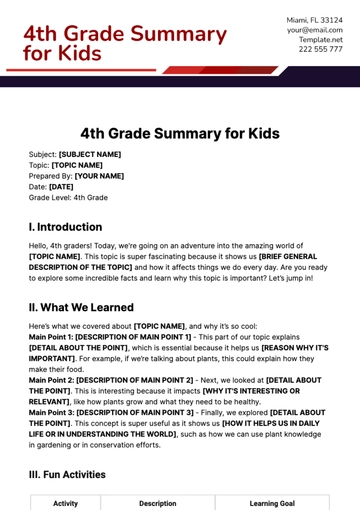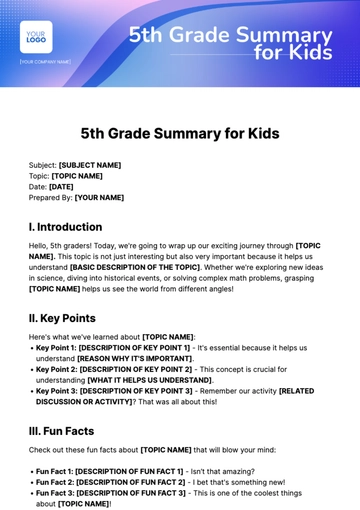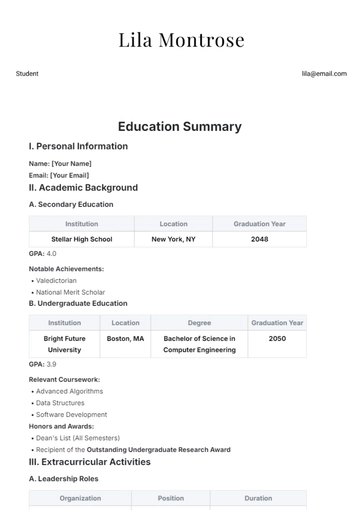Free Affiliate Marketing Campaign Performance Summary

The campaign performance summary for [2050] provides an in-depth analysis of [Your Company Name]'s affiliate marketing efforts. This report evaluates the outcomes of various campaigns, identifies trends, and highlights areas of success and improvement. The insights from this summary will guide strategy refinements, ensuring continued growth and effectiveness in affiliate marketing.
I. Affiliate Partner Performance
Affiliate partner performance is critical for campaign success. This section evaluates contributions from key partners.
Affiliate Partner | Revenue Generated | Conversion Rate | Traffic Share |
|---|---|---|---|
[Name] | $1,200,000 | 12% | 18% |
[Name] | $950,000 | 10% | 15% |
[Name] | $750,000 | 8% | 12% |
[Name] | $500,000 | 6% | 8% |
[Name] | $1,600,000 | 7% | 47% |
Key partners contributed significantly to total revenue, with [Name] leading in both revenue and conversion efficiency. Efforts to strengthen relationships with top performers while supporting emerging affiliates will further enhance results.
II. Campaign Effectiveness by Channel
Understanding the performance of various marketing channels is essential for resource allocation.
Channel | Revenue Generated | Conversion Rate | Traffic Share |
|---|---|---|---|
Paid Search | $2,000,000 | 10% | 30% |
Email Marketing | $1,500,000 | 15% | 25% |
Social Media | $1,000,000 | 7% | 20% |
Content Marketing | $500,000 | 6% | 10% |
Others | $1,000,000 | 5% | 15% |
Paid search emerged as the most lucrative channel, with email marketing boasting the highest conversion rate. Social media campaigns showed strong traffic generation but lower conversions, highlighting the need for improved audience targeting.
III. Challenges and Areas for Improvement
Identifying challenges provides opportunities for refining strategies and improving performance.
Low Emerging Market Penetration: Campaigns targeting emerging markets underperformed, contributing only [10%] of revenue. Tailored strategies are required for these regions.
Affiliate Turnover: High turnover among small affiliates impacted revenue consistency. Addressing affiliate concerns can improve retention.
Content Personalization: Limited personalization in campaigns affected customer engagement. AI tools are being explored to enhance this aspect.
Budget Constraints: Budget allocation for testing new strategies remained limited. A review of financial priorities is necessary.
Data Integration: Inconsistent data across platforms created reporting challenges. A unified analytics tool is being implemented.
IV. Recommendations
Based on the findings, this section outlines actionable recommendations to enhance performance in the coming year.
Expand to Emerging Markets: Allocate resources to campaigns targeting underperforming regions. Partnering with local influencers may drive better results.
Enhance Affiliate Relationships: Offer tiered incentives to retain and motivate top-performing affiliates. Personalized support can further boost collaboration.
Focus on Mobile Optimization: Continue optimizing mobile experiences, as mobile traffic and conversions dominate. Responsive design remains crucial.
Invest in AI Tools: Leverage AI for content personalization and predictive analytics. This will improve engagement and decision-making.
Diversify Channels: Experiment with emerging platforms like video-first social media apps. This can tap into untapped demographics.
The [2050] affiliate marketing campaigns by [Your Company Name] demonstrated significant progress in revenue growth and engagement metrics. Key partnerships and effective channel strategies contributed to these outcomes. This summary underscores the importance of continuous improvement and adaptability in the dynamic world of affiliate marketing.
- 100% Customizable, free editor
- Access 1 Million+ Templates, photo’s & graphics
- Download or share as a template
- Click and replace photos, graphics, text, backgrounds
- Resize, crop, AI write & more
- Access advanced editor
Track success with the Affiliate Marketing Campaign Performance Summary Template from Template.net. Fully editable and customizable, this template is perfect for analyzing and presenting key metrics from affiliate campaigns. Use our AI Editor Tool to customize chart and branding. Its structured layout ensures a professional report that highlights achievements and opportunities for growth.





























